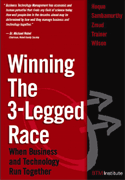
By Faisal Hoque, V. Sambamurthy, Robert Zmud, Tom Trainer and Carl Wilson
Prentice Hall, Dec. 2005
256 PAGES, $27.99
If there is one thing the best CIOs have learned, it’s this: Managing technology is as important as the technology itself. Every company can buy the same machines and software, so the only source of competitive advantage lies in how the stuff is used.
In short, IT must be managed so that it promotes companies’ overall strategic objectives as well as those of IT, though that is far from easy.
But the authors of this book—Hoque, chairman and CEO of Enamics; Sambamurthy, a professor at Michigan State University’s business school; Zmud, professor at the University of Oklahoma’s business school; Trainer, global CIO at PepsiCo; and Wilson, CIO at Marriott International—have come up with a wonderful metaphor: Managing IT is like running a three-legged race. And in IT management, as in the popular picnic game, the same core principle holds true: The teammates who work best together win.
Unfortunately, the specifics are daunting: The authors—all members of the Business Technology Management Institute—have identified 17 corporate capabilities (such as strategic planning and budgeting), across four functional areas—governance and organization; managing technology investments; strategy and planning; and strategic enterprise architecture—where business and technology must mesh. In other words, you need to integrate processes, organization, information and technology. No wonder so few companies do it well.
Hoque et al. have also identified five stages that a company must pass through in order to achieve true integration:
- Establish a baseline. Where are you on the path to integration?
- Educate and align the key players on what needs to be done.
- Design processes to make it happen.
- Implement.
- Optimize and maintain best practices.
The stages serve as both a template to follow and a diagnostic. If your firm has not mastered one or more of the five steps, something is wrong.
The good news is that the authors have performed a useful service. By providing a potential framework—they
call it the BTM Maturity Model—they have simplified the seemingly overwhelming task of integrating business and technology over 17 areas.
Of course, the actual implementation is the sticky part. And—here’s the bad news—implementation is a topic that the authors, in essence, sidestep. To say, as they do, that you can begin the implementation process anywhere is probably true, but not particularly helpful. What they are talking about is (at most companies) analogous to fixing a flat tire while the car is moving. The authors concede the point, saying the integration process is best done iteratively, rather than all at once, but few CEOs have that kind of patience.
To their credit, the authors concede that while this book contains their latest thinking, the field is still evolving. Even a three-legged race starts with a good first step.
PAUL B. BROWN is the author of numerous business books, including The Rules of Business: 55 Essential Ideas to Help Smart People (and Organizations) Perform at Their Best, just published by Doubleday.